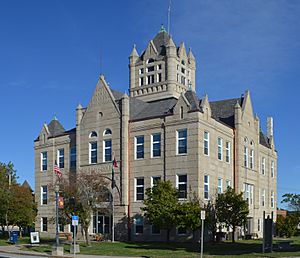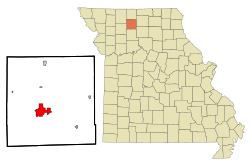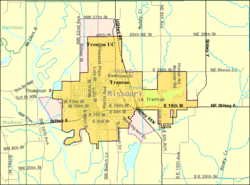Trenton, Missouri facts for kids
Quick facts for kids
Trenton, Missouri
|
|
|---|---|

Grundy County Courthouse
|
|
| Nickname(s):
City of friendly citizens
|
|

Location of Trenton, Missouri
|
|

U.S. Census Map
|
|
| Country | United States |
| State | Missouri |
| County | Grundy |
| Area | |
| • Total | 6.74 sq mi (17.44 km2) |
| • Land | 6.45 sq mi (16.70 km2) |
| • Water | 0.29 sq mi (0.75 km2) |
| Elevation | 768 ft (234 m) |
| Population
(2020)
|
|
| • Total | 5,609 |
| • Density | 870.02/sq mi (335.90/km2) |
| Time zone | UTC-6 (Central (CST)) |
| • Summer (DST) | UTC-5 (CDT) |
| ZIP code |
64683
|
| Area code(s) | 660 |
| FIPS code | 29-73816 |
| GNIS feature ID | 2397050 |
| Website | City of Trenton |
Trenton is a city located in Grundy County, Missouri, in the United States. In 2020, about 5,609 people lived there. Trenton is also the county seat of Grundy County, which means it's where the main government offices for the county are. Long ago, Trenton was known for making a lot of vienna sausages at a large factory.
Contents
History of Trenton
Trenton has several important historical places. These places are listed on the National Register of Historic Places, which means they are special and protected. Some of these include:
- The Crowder State Park Vehicle Bridge
- The Jewett Norris Library
- The Plaza Hotel
- The St. Philip's Episcopal Church
- The Trenton High School
- The WPA Stock Barn and Pavilion
The Ruskin College Story
In 1869, the Chicago, Rock Island and Pacific Railroad came to Trenton, making it easier to travel and transport goods. Because of this, Avalon College, which was founded in Avalon, Missouri in 1869, moved to Trenton in 1890.
The college faced money problems and almost closed. But in 1900, George McAnelly Miller helped turn things around. He was joined by Walter Vrooman, who had just come back from Oxford, England. In Oxford, Vrooman had started a special university called "Ruskin Hall," which was known as the "College for the People." It was based on the ideas of John Ruskin.
Vrooman gave 1,500 acres (about 6 square kilometers) of land to Avalon College, and it was renamed Ruskin College. This college was unique because it loaned money directly to students. Students could also work at the school's businesses, like canning, farming, and woodworking, to help pay for their education. Unlike the Oxford school, Ruskin College in Trenton also allowed women to attend.
Vrooman then tried to buy many businesses in Trenton, including three grocery stores, a hardware store, and a drug store. He paid for everything with cash through a group called the Western Cooperative Association. The idea was that members of this group who spent at least $300 in one of its stores would get money back at the end of the year. The New York Times even wrote an article about it in 1902, calling it "Buying a Town Outright."
However, the Ruskin experiment didn't last. By 1903, people in Trenton didn't like Vrooman's business ideas. Also, Vrooman's wife divorced him, saying he had wasted a lot of her money.
Miller moved the college to Glen Ellyn, Illinois, near Chicago, in 1903. There, it combined with 12 other colleges and had many students. But problems quickly started there too, and the main school building burned down after being hit by lightning.
In 1906, Miller moved the college again, this time to Ruskin, Florida. Land in Trenton was traded for a much larger area in Florida. Many buildings on the Florida campus also burned in 1918. When Miller passed away in 1919, the college finally closed.
Later, in 1925, Trenton Junior College was started. Today, it is known as North Central Missouri College (NCMC). This college has grown a lot and is now an important place for learning about agriculture (farming) and nursing in Missouri. NCMC has expanded its main campus and also has a special agricultural campus south of Trenton. This campus, called the Barton Farm Campus, has classrooms, a wind turbine, a pond, and test plots on 138 acres of farmland.
Geography and Climate
Trenton is located on a flat area near the Thompson River to the west and its smaller stream, Muddy Creek, to the east. Major roads like U.S. Route 65 and Missouri Route 6 pass by or through the city. The city of Chillicothe is about nineteen miles south of Trenton.
The United States Census Bureau says that Trenton covers about 6.74 square miles (17.44 square kilometers). Most of this area is land, with a small part being water.
Trenton's Weather Patterns
Trenton experiences a variety of weather throughout the year. Summers are generally warm, and winters are cold. The city gets a good amount of rain, especially in spring and summer. Snowfall is common in the winter months.
| Climate data for Trenton, Missouri (1991–2020 normals, extremes 1895–present) | |||||||||||||
|---|---|---|---|---|---|---|---|---|---|---|---|---|---|
| Month | Jan | Feb | Mar | Apr | May | Jun | Jul | Aug | Sep | Oct | Nov | Dec | Year |
| Record high °F (°C) | 69 (21) |
82 (28) |
88 (31) |
94 (34) |
105 (41) |
107 (42) |
114 (46) |
113 (45) |
106 (41) |
98 (37) |
84 (29) |
72 (22) |
114 (46) |
| Mean daily maximum °F (°C) | 34.8 (1.6) |
40.3 (4.6) |
52.5 (11.4) |
63.9 (17.7) |
74.6 (23.7) |
84.5 (29.2) |
88.9 (31.6) |
86.9 (30.5) |
79.4 (26.3) |
66.7 (19.3) |
51.7 (10.9) |
39.5 (4.2) |
63.6 (17.6) |
| Daily mean °F (°C) | 25.5 (−3.6) |
30.0 (−1.1) |
41.2 (5.1) |
52.3 (11.3) |
63.6 (17.6) |
73.6 (23.1) |
77.8 (25.4) |
75.5 (24.2) |
67.1 (19.5) |
54.7 (12.6) |
41.3 (5.2) |
30.4 (−0.9) |
52.8 (11.6) |
| Mean daily minimum °F (°C) | 16.3 (−8.7) |
19.8 (−6.8) |
29.9 (−1.2) |
40.6 (4.8) |
52.7 (11.5) |
62.7 (17.1) |
66.8 (19.3) |
64.1 (17.8) |
54.8 (12.7) |
42.6 (5.9) |
31.0 (−0.6) |
21.4 (−5.9) |
41.9 (5.5) |
| Record low °F (°C) | −26 (−32) |
−25 (−32) |
−15 (−26) |
9 (−13) |
22 (−6) |
42 (6) |
46 (8) |
42 (6) |
27 (−3) |
3 (−16) |
−6 (−21) |
−24 (−31) |
−26 (−32) |
| Average precipitation inches (mm) | 1.13 (29) |
1.70 (43) |
2.60 (66) |
3.90 (99) |
6.02 (153) |
4.76 (121) |
4.77 (121) |
4.27 (108) |
3.88 (99) |
3.08 (78) |
2.22 (56) |
1.74 (44) |
40.07 (1,018) |
| Average snowfall inches (cm) | 4.7 (12) |
4.7 (12) |
2.9 (7.4) |
0.3 (0.76) |
0.0 (0.0) |
0.0 (0.0) |
0.0 (0.0) |
0.0 (0.0) |
0.0 (0.0) |
0.2 (0.51) |
0.9 (2.3) |
3.5 (8.9) |
17.2 (44) |
| Average precipitation days (≥ 0.01 in) | 5.6 | 7.1 | 8.9 | 10.6 | 12.3 | 10.1 | 8.2 | 9.0 | 7.2 | 8.3 | 6.1 | 6.4 | 99.8 |
| Average snowy days (≥ 0.1 in) | 2.7 | 2.7 | 1.1 | 0.2 | 0.0 | 0.0 | 0.0 | 0.0 | 0.0 | 0.2 | 0.7 | 3.1 | 10.7 |
| Source: NOAA | |||||||||||||
Population and People
The population of Trenton has changed over the years. Here's how it has grown and shrunk since 1860:
| Historical population | |||
|---|---|---|---|
| Census | Pop. | %± | |
| 1860 | 617 | — | |
| 1870 | 920 | 49.1% | |
| 1880 | 3,312 | 260.0% | |
| 1890 | 5,039 | 52.1% | |
| 1900 | 5,396 | 7.1% | |
| 1910 | 5,656 | 4.8% | |
| 1920 | 6,951 | 22.9% | |
| 1930 | 6,992 | 0.6% | |
| 1940 | 7,046 | 0.8% | |
| 1950 | 6,157 | −12.6% | |
| 1960 | 6,262 | 1.7% | |
| 1970 | 6,063 | −3.2% | |
| 1980 | 6,811 | 12.3% | |
| 1990 | 6,129 | −10.0% | |
| 2000 | 6,216 | 1.4% | |
| 2010 | 6,001 | −3.5% | |
| 2020 | 5,609 | −6.5% | |
| U.S. Decennial Census | |||
In 2010, there were 6,001 people living in Trenton. Most people in the city were White (96.0%). A small number of people were African American, Native American, or Asian. About 2.4% of the population identified as Hispanic or Latino.
The average age in Trenton in 2010 was about 41.6 years old. About 22.6% of the people were under 18, and 22.8% were 65 or older. There were more females (54.3%) than males (45.7%) living in the city.
Education in Trenton
Public schools in Trenton are managed by the Trenton R-IX School District. Students attend schools within this district.
Trenton also has a public library called the Grundy County-Jewett Norris Library. Libraries are great places to read books, study, and learn new things.
Notable People from Trenton
Many interesting people have come from Trenton, Missouri. Some of them include:
- Roy Gardner
- John Hack, a war hero
- Yank Lawson, a trumpet player known for Dixieland music
- Imogene Lynn, a pop singer
- Gregg Miller, an inventor and author
- J. M. Whorton, a politician
See also
 In Spanish: Trenton (Misuri) para niños
In Spanish: Trenton (Misuri) para niños


